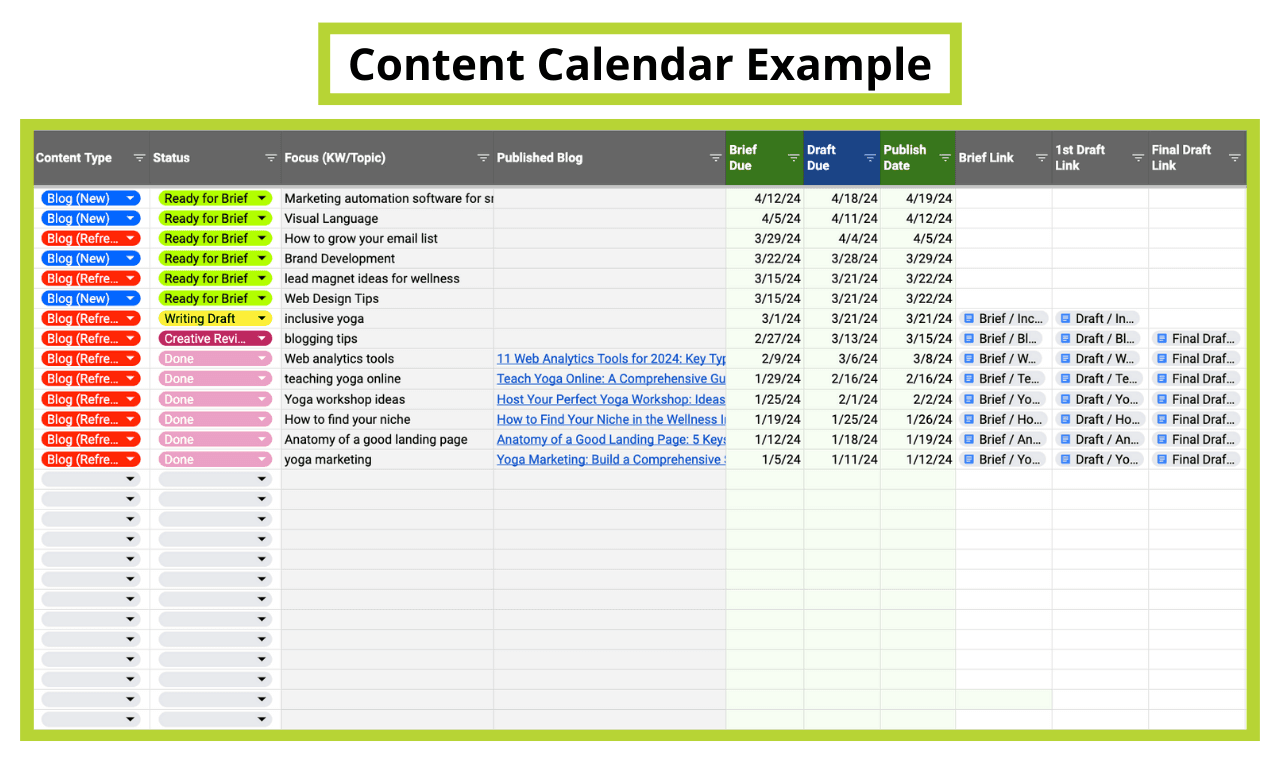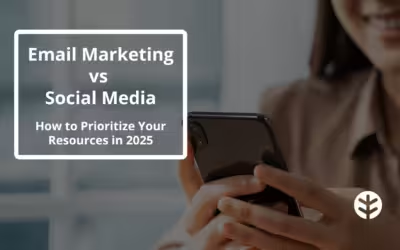Blogging is a powerful tool for yoga teachers and other wellness professionals looking to connect with their audience, showcase their expertise, and grow their business. Creating effective blog content that resonates with your readers and supports your goals can feel like a daunting task.
By using best practices for blogs and avoiding common blogging mistakes, you can create content that attracts new clients and establishes you as a trusted authority in your niche.
We’ve compiled top blogging advice, tips, and tricks to help you get started, improve your blog, and create compelling content that resonates with your current and future clients.
Whether you’re just starting or looking to revamp your existing blog, this article will provide you with a clear roadmap for success and helpful resources to streamline your efforts.
Let’s dive in!
Table of Contents:
- How Can a Blog Help Your Business?
- 6 Blog Best Practices to Make Your Content Shine
- Tools and Resources to Up Your Game
How Can a Blog Help Your Business?
Creating and maintaining a well-crafted blog can be a powerful tool for yoga teachers, fitness instructors, and wellness professionals looking to expand their client bases and grow their businesses.
Your business blog is not a diary or a collection of random thoughts (though personal blogs are great for that). Your blog should be intentionally planned and aligned with your business strategy.
Blog content requires the same attention and care as the rest of your business assets (physical, digital, etc.). You wouldn’t update your business hours or change prices without reflecting that on your website, right? Blog content is no different.
As time passes…
- Statistics change
- Advice and best practices shift
- New trends replace old
- Even your audience’s needs and preferences will shift
Regularly audit your content and update audience research to ensure your blogs stay relevant and helpful. Don’t let your blog become irrelevant and stale.
A thoughtfully maintained blog can help you in several ways, including:
- Attract new students: Consistently providing valuable content can improve your search engine rankings, drive more traffic to your website, secure more quality leads, and help you cultivate a loyal following.
- Boost your Search Engine Optimization (SEO): By regularly incorporating relevant keywords, you can increase your website’s visibility without getting too technical.
- Showcase your passion and expertise: By sharing your knowledge and insights, you establish yourself as a credible authority in your practice or field, building trust with your audience.
- Engage in continuing education: Explore new subjects and ideas related to your business, keeping your teaching fresh and relevant.
- Develop your teaching voice and style: Writing about your practice helps you refine your teaching approach and effectively connect with your students.
Blogging Mistakes to Avoid
You know the importance of good form in setting a robust and solid foundation for a wellness practice. You also know how difficult it can be to correct your course after introducing bad form at an early stage. Blogging is no different.
When starting your blog, there are serious mistakes to avoid. Falling into these traps can lead to a lack of engagement, decreased traffic, and, ultimately, a less effective blog.
We don’t expect you to be a pro right out of the gate — making some mistakes is part of the journey — but the more awareness you can begin with, the better.
Here are the top 5 blogging mistakes to avoid:
- Inconsistent posting: Irregular updates can cause your readers to lose interest and disengage.
- Failing to proofread: Typos can undermine your credibility and professionalism.
- Neglecting SEO: Ignoring keywords and SEO can limit your blog’s visibility and reach.
- Lack of focus: Straying from your specialty area (niche) can confuse readers and dilute your message.
- Ignoring audience engagement: Failing to respond to comments and feedback can discourage reader interaction.
6 Blog Best Practices to Make Your Content Shine
In this section, we share proven and essential best practices to help you craft compelling, informative, and optimized blog posts.
By following these tried-and-true blogging tips and tricks, you’ll quickly find that your blogs will shine through searches, turn visitors into readers, and turn readers into clients.
- Understand Your Audience
- Create a Content Calendar and Plan Ahead
- Basic SEO Tactics and Keyword Research
- Write Helpful and Engaging Content
- Consider Images and Interactive Elements
- Get the Word Out on Social Media
Understand Your Audience
It’s always best to start by establishing a basic understanding of WHO you’re writing to – Audience research is an essential step that should not be overlooked.
By taking the time to understand your target audience—whether it’s the people in your classrooms or your dream clients—you can craft blog posts that speak directly to their needs, interests, and pain points.
This focus on the front end will help you show your audience you understand them and establish your brand as a trusted authority in the yoga and wellness space.
Effective audience research should answer three key questions:
- What motivates them?
- What are their pain points?
- Why should they be interested in your offerings?
With insights into your audience’s motivations and challenges, you can develop a deep understanding of what motivates them. From there, you can create content that helps them along their journey for answers and insight.
You might be wondering, “Who is my audience?” That is totally normal.
The research process helps you find the answer by identifying different personas within your target market — a representative figure representing a group or demographic — allowing you to tailor your messaging and content to each.
By understanding each persona’s unique pain points and aspirations, you can create targeted content that speaks directly to their needs. This will increase the frequency with which they come to you for answers and their trust in your authority to provide accurate, helpful information.
To conduct thorough audience research, consider the following methods:
- Surveys and questionnaires: Ask your existing audience — in person and online — about their preferences, challenges, and goals.
- Social media listening: Pay attention to relevant conversations and engage with your target audience on social platforms.
- Competitor analysis: Study your competitors’ content and audience interactions to identify gaps and opportunities.
- Analytics review: Use analytics tools to gain insights into your website visitors’ behavior and demographics.
- Customer interviews: Conduct one-on-one interviews with your ideal clients (people who represent personas) to gain deeper insights into their needs and expectations.
Strategic Planning for Your Blog
Don’t wing it. Planning ahead is crucial for producing purposeful and effective blog content in the yoga and wellness space. If you organize and establish clear goals for each post for the week or month ahead, you can ensure that your content is relevant, timely, and supports your overall business objectives.
This strategic approach helps you maintain a consistent posting schedule, keeping your readers engaged and returning for more.
Create a Content Calendar
Unfamiliar with the concept? Simply put, a content calendar is a research-based schedule (quickly done on any digital calendar app) that collects outlines for each blog post on the dates they will be published.
Each post outline should include your main points, supporting evidence, and a clear call-to-action (CTA) that guides your readers to take the next step, whether signing up for a class or subscribing to your newsletter.

What’s the point of building out a proper content calendar?
- Consistency: A content calendar helps you maintain a regular posting schedule, which is essential for building a loyal audience and establishing your brand as a reliable source of information.
- Strategic alignment: Planning ahead allows you to create content that aligns with your overall marketing strategy, ensuring that your blog posts complement your other promotional efforts across various platforms.
- Improved organization: A content calendar allows you to keep track of your ideas, deadlines, and progress, reducing stress and allowing you to focus on creating high-quality content.
Basic SEO Tactics and Keyword Research
As we mentioned earlier, SEO, or search engine optimization, is the practice of improving your website’s visibility and ranking on search engine results pages, like Google, Safari, or Bing.
By optimizing your blog content for search engines (which sounds a lot more technical than it really is), you make it easier for best-fit customers to find your website who search for topics related to your health and wellness business. This, in turn, can lead to increased traffic, brand awareness, and potential clients.
Keyword Research
A crucial aspect of SEO is keyword research, which involves identifying the phrases and terms your target audience uses when searching for content related to your business.
For example, “Vinyasa Yoga,” “Meditation Class,” and “Intermediate Pilates” are all terms a potential client might use to search for a nearby class; if your blog has those keywords present on it, there’s a better chance it will appear in the search results.
By strategically incorporating these keywords throughout your blog posts, you can signal to search engines that your content is relevant and valuable to users searching for those terms.
Here are some essential SEO blogging tips and tactics to keep in mind:
- Choose a Target Keyword for Each Blog Post: A target keyword is the main word or phrase you want your blog post to rank for in search engines. You should include it in your blog title. Example: Vinyasa Yoga
- Include a Few Semantically Related Keywords: Semantically related keywords are terms closely related to your target keyword. They help search engines better understand your content’s context. Ideally, include them frequently, naturally, and early in your blog. Example: Flow, Breath Work, Gentle Yoga
- Write an Optimized Meta Title: A meta title is the title that appears in search results and, it follows, should be clear and direct. Most often, it will be your blog title (including your target keyword) and should grab readers’ attention. (50-60 characters)
- Write an Optimized Meta Description: A meta description is a brief summary of your blog post that appears in search results. (100-160 characters)
- Include Alt Text for Images: Alt text is a no-fluff description of an image that helps search engines and the visually impaired understand its content. It improves accessibility and SEO.
Increase Your Visibility on Google and Grow Business!
Download our Local SEO Checklist for Small Businesses to unlock the power of organic search.
Write Helpful and Engaging Content
Now it’s time to write. But what to write and how? With so much information available online, simply regurgitating what already exists is not only pointless but also damages your credibility as an expert in your field.
To stand out and provide genuine value to your readers, you must create original, relevant, and helpful content that directly addresses their pain points and shows the value of what you want to focus on.
Remember, your readers look to your business blog for practical advice and solutions, not a personal diary entry or high-brow literature.
When crafting your blog posts, prioritize clarity and brevity. While it may be tempting to use flowery language or elaborate metaphors, you should do so sparingly—they are easy to overdo, which makes content boring and possibly confusing.
To help you create compelling, original, and valuable blog content, consider the following best practices:
- Keep it human: While it may be tempting to use AI to generate content, especially if you don’t have your writing confidence yet,
- Who, What, Where, When, Why, How?: Answer all that apply – Who is this blog for? What is it trying to communicate? These kinds of simple questions are a good filter for gauging the clarity of your content. Do you know the answers to these going into your writing process? More importantly, do you know the answers when you read the final blog?
- Pay attention to the questions you hear: Keep track of the common questions that arise during your classes, sessions, or online. Develop tutorials or explainers that address these concerns, showcasing your expertise and demonstrating your commitment to helping your students grow.
- Connect a personal story to your practice: Share real-life experiences that illustrate how your offering extends beyond the studio or gym. By showing how your practice applies to everyday situations, you’ll help your audience understand the actual value of what you provide. Here, personal details add color and interest. Just make sure they support the main point you’re out to share.
- Conduct a formal interview: Collaborate with respected figures in your field, inspirational students, or admired mentors. Share these interviews in various formats (video, audio, or written) to provide fresh perspectives and cross-promotion opportunities.
- Be a student: You don’t have to be an expert at everything. Use your blog as a platform to explore topics you’re passionate about learning — your passion will come through. Share your findings with your audience, showcasing your dedication to continuous growth and improvement in your practice.
Consider Images and Interactive Elements
Don’t forget to decorate! Strategically incorporating photos, images, videos, and other interactive elements into your blog content can enhance your readers’ experience and engagement.
Visual content helps break up large blocks of text, making your posts more digestible and visually appealing.
Infographics and how-to videos can also help illustrate complex concepts, evoke emotions, and provide additional context to your written content, particularly with visitors who learn best in ways other than reading.
Plus, articles with images tend to receive more shares and backlinks, boosting your blog’s visibility and search engine rankings.
🚨 Warning: Use visual elements strategically and purposefully. Overloading blog posts with too many visuals and/or irrelevant/low-quality visuals is distracting. It may also slow down your page loading times, which negatively impacts user experience and SEO.
Here are some of the most common types to consider:
- Feature images: Eye-catching header images that set the tone for your blog post and draw readers in.
- Infographics: Visual representations of data, statistics, or processes that make complex information more accessible and shareable.
- Charts and graphs: Visual aids that help illustrate numerical data or trends, making them easier to understand and interpret.
- Embedded videos: Relevant video content that complements your written content and provides a more engaging, multisensory experience for your audience.
- Interactive elements: Quizzes, polls, or clickable elements that encourage reader participation and can help increase time spent on your page.
- Illustrations and decorative art: Best when used sparingly, but visual accents can add a crafted feel, reinforce your brand, and add a pop of fun visual interest.

Get the Word Out on Social Media
As you know, posting on social media is crucial for connecting with your current and future clients, building brand awareness, driving traffic to your website, and boosting registrations and sales.
By sharing your blog content on social platforms, you can engage with your followers, establish yourself as a thought leader in your industry, stand out from your competition, and ultimately attract more clients to your business.
Here are a few key benefits you may experience by promoting your blog content on social media:
- Awareness: Sharing your blog posts on social media expands your reach, exposing your content to a broader audience and increasing brand awareness.
- Site traffic: By including links to your blog posts in your social media updates, you can drive more traffic to your website, potentially leading to increased client inquiries and sales.
- Backlinks: When other websites or social media users share your blog content and link back to your site, it can improve your search engine rankings and drive even more traffic. The analytics tool provider SEMrush has created an excellent beginner-level guide to linking.
Expert Tools & Resources to Up Your Game
Having the right tools in your arsenal lets you create higher-quality blog content for less effort. While these tools can benefit all small business owners in this space, the specific combination of tools that works best may vary depending on your individual needs and preferences.
We’ve compiled a list of some of our favorite and most valuable resources for creating, optimizing, and promoting blog content:
- Grammarly: A writing assistant that checks your blog posts for grammar, spelling, and punctuation errors, helping to ensure your content is polished and professional.
- Hemingway: An online editor that analyzes your writing’s readability, highlighting complex sentences and suggesting improvements to make your blog posts clearer and more engaging.
- CapitalizeMyTitle: A tool that automatically capitalizes your blog post titles according to various style guides, saving you time and ensuring consistency.
- SEMrush: An all-in-one SEO and digital marketing tool that helps you research keywords, analyze competitors, and optimize your blog posts for search engines.
- SEO-Meta-in-One-Click: A browser extension that allows you to quickly check and edit your blog post’s SEO meta tags, including title, description, and keywords.
- Canva: A user-friendly graphic design tool that enables you to create visually appealing images, infographics, and social media graphics for your blog posts.
- Opus: An AI-powered tool that generates blog post ideas, outlines, and content based on your keywords, helping you overcome writer’s block and save time.
- Google Trends: A free tool that shows the popularity of search terms over time, helping you identify trending topics to write about on your blog.
- Unsplash: A website offering a vast collection of high-quality, royalty-free images that you can use to enhance your blog posts without worrying about copyright issues.
- TinyPNG: A tool that compresses your blog post images without sacrificing quality, helping to improve your website’s loading speed and performance.
- CoSchedule Headline Analyzer: A tool that analyzes your blog post headlines and suggests improvements to make them more engaging, clickable, and SEO-friendly.
Develop Your Marketing Strategy for Growth in 2024
Download our 2024 Marketing Checklist to get step-by-step guidance.
Explore the OfferingTree Blog for More Expert Advice
By putting these strategies into action and staying committed to your blogging journey, you’ll be well on your way to building a solid online presence, connecting with your ideal clients, and growing your business.
At OfferingTree, we don’t just talk the talk. We walk the walk. Explore our blog for genuinely helpful and educational marketing and business resources for wellness practitioners, entrepreneurs, and professionals.
We work hard to ensure our content is a cut above the rest through extensive research, experience, and expert contributions (as well as practicing the advice we’ve given here).
From social media strategies to email marketing advice (and the platform to support it all), our blog is your go-to source for staying up on the latest trends and best practices in the industry.



![How to Ask Customers for Reviews [with Email Templates]](https://www.offeringtree.com/wp-content/uploads/2021/10/how-to-ask-for-customer-reviews-cover-image-400x250.avif)
